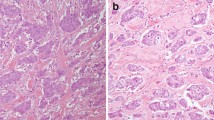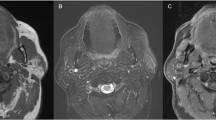Abstract
More than 15 years ago, seminal studies by Dr. E. Leon Barnes and colleagues transformed our understanding of salivary duct carcinoma (SDC) and, in doing so, paved the way for contemporary diagnostic and therapeutic approaches to this aggressive salivary adenocarcinoma. In particular, attention to the apocrine phenotype of SDC and expression of androgen receptor (AR) by immunohistochemistry has improved the diagnostic accuracy and showed how SDC can be reliably distinguished from its morphologic mimics (i.e., other salivary gland carcinomas with high grade transformation, low grade cribriform cystadenocarcinoma, and squamous cell carcinomas involving parotid). Furthermore, the observation that SDC shares AR expression with prostate cancer and apocrine breast cancer foresaw the discovery of common molecular alterations between SDC and these tumor types and draw attention to androgen deprivation therapy for SDC patients.
Similar content being viewed by others
References
Kleinsasser O, Klein HJ, Hubner G. Salivary duct carcinoma. A group of salivary gland tumors analogous to mammary duct carcinoma. Arch Klin Exp Ohren Nasen Kehlkopfheilkd. 1968;192(1):100–5.
Fan CY, Wang J, Barnes EL. Expression of androgen receptor and prostatic specific markers in salivary duct carcinoma: an immunohistochemical analysis of 13 cases and review of the literature. Am J Surg Pathol. 2000;24(4):579–86.
Kapadia SB, Barnes L. Expression of androgen receptor, gross cystic disease fluid protein, and CD44 in salivary duct carcinoma. Mod Pathol. 1998;11(11):1033–8.
Williams L, Thompson LD, Seethala RR, Weinreb I, Assaad AM, Tuluc M, et al. Salivary duct carcinoma: the predominance of apocrine morphology, prevalence of histologic variants, and androgen receptor expression. Am J Surg Pathol. 2015;39(5):705–13. doi:10.1097/PAS.0000000000000413.
Williams MD, Roberts D, Blumenschein GR Jr, Temam S, Kies MS, Rosenthal DI, et al. Differential expression of hormonal and growth factor receptors in salivary duct carcinomas: biologic significance and potential role in therapeutic stratification of patients. Am J Surg Pathol. 2007;31(11):1645–52. doi:10.1097/PAS.0b013e3180caa09900000478-200711000-00003.
Di Palma S, Simpson RH, Marchio C, Skalova A, Ungari M, Sandison A, et al. Salivary duct carcinomas can be classified into luminal androgen receptor-positive, HER2 and basal-like phenotypes*. Histopathology. 2012. doi:10.1111/j.1365-2559.2012.04252.x.
Ko YH, Roh JH, Son YI, Chung MK, Jang JY, Byun H, et al. Expression of mitotic checkpoint proteins BUB1B and MAD2L1 in salivary duct carcinomas. J Oral Pathol Med. 2010;39(4):349–55. doi:10.1111/j.1600-0714.2009.00835.x.
Nagao T, Gaffey TA, Visscher DW, Kay PA, Minato H, Serizawa H, et al. Invasive micropapillary salivary duct carcinoma: a distinct histologic variant with biologic significance. Am J Surg Pathol. 2004;28(3):319–26.
Henley JD, Seo IS, Dayan D, Gnepp DR. Sarcomatoid salivary duct carcinoma of the parotid gland. Hum Pathol. 2000;31(2):208–13.
Nagao T, Gaffey TA, Serizawa H, Iwaya K, Watanabe A, Yoshida T, et al. Sarcomatoid variant of salivary duct carcinoma: clinicopathologic and immunohistochemical study of eight cases with review of the literature. Am J Surg Pathol. 2004;122(2):222–31. doi:10.1309/5J40-08QR-Y1HW-W5W4.
Simpson RH, Prasad AR, Lewis JE, Skalova A, David L. Mucin-rich variant of salivary duct carcinoma: a clinicopathologic and immunohistochemical study of four cases. Am J Surg Pathol. 2003;27(8):1070–9.
Hungermann D, Roeser K, Buerger H, Jakel T, Loning T, Herbst H. Salivary duct carcinoma. Pathologe. 2005;26(5):353–8. doi:10.1007/s00292-005-0775-0.
Griffith CC, Seethala RR, Luvison A, Miller M, Chiosea SI. PIK3CA mutations and PTEN loss in salivary duct carcinomas. Am J Surg Pathol. 2013;37(8):1201–7. doi:10.1097/PAS.0b013e3182880d5a.
Foote FW Jr, Frazell EL. Tumors of the major salivary glands. Cancer. 1953;6(6):1065–133.
In: Weinreb I, Seethala RR, Chiosea SI, Perez-Ordonez B, Hyrcza M, Zhang L et. al., editors. Molecular analysis of low-grade cribriform cystadenocarcinoma & related in-situ and invasive carcinomas. New York: Nature Publishing Group, 2016.
Brandwein-Gensler M, Hille J, Wang BY, Urken M, Gordon R, Wang LJ, et al. Low-grade salivary duct carcinoma: description of 16 cases. Am J Surg Pathol. 2004;28(8):1040–4.
Delgado R, Klimstra D, Albores-Saavedra J. Low grade salivary duct carcinoma. A distinctive variant with a low grade histology and a predominant intraductal growth pattern. Cancer. 1996;78(5):958–67. doi:10.1002/(SICI)1097-0142(19960901)78:5<958::AID-CNCR4>3.0.CO;2-8.
Isola JJ. Immunohistochemical demonstration of androgen receptor in breast cancer and its relationship to other prognostic factors. J Pathol. 1993;170(1):31–5. doi:10.1002/path.1711700106.
Farmer P, Bonnefoi H, Becette V, Tubiana-Hulin M, Fumoleau P, Larsimont D, et al. Identification of molecular apocrine breast tumours by microarray analysis. Oncogene. 2005;24(29):4660–71. doi:10.1038/sj.onc.1208561.
Perou CM, Sorlie T, Eisen MB, van de Rijn M, Jeffrey SS, Rees CA, et al. Molecular portraits of human breast tumours. Nature. 2000;406(6797):747–52. doi:10.1038/35021093.
Hirshfield KM, Ganesan S. Triple-negative breast cancer: molecular subtypes and targeted therapy. Curr Opin Obstet Gynecol. 2014;26(1):34–40. doi:10.1097/GCO.0000000000000038.
Lehmann BD, Bauer JA, Chen X, Sanders ME, Chakravarthy AB, Shyr Y, et al. Identification of human triple-negative breast cancer subtypes and preclinical models for selection of targeted therapies. J Clin Invest. 2011;121(7):2750–67. doi:10.1172/JCI45014.
Turner NC, Reis-Filho JS. Tackling the diversity of triple-negative breast cancer. Clin Cancer Res. 2013;19(23):6380–8. doi:10.1158/1078-0432.CCR-13-0915.
Dumay A, Feugeas JP, Wittmer E, Lehmann-Che J, Bertheau P, Espie M, et al. Distinct tumor protein p53 mutants in breast cancer subgroups. Int J Cancer. 2013;132(5):1227–31. doi:10.1002/ijc.27767.
Dalin MG, Desrichard A, Katabi N, Makarov V, Walsh LA, Lee KW, et al. Comprehensive Molecular Characterization of Salivary Duct Carcinoma Reveals Actionable Targets and Similarity to Apocrine Breast Cancer. Clin Cancer Res. 2016;22(18):4623–33. doi:10.1158/1078-0432.CCR-16-0637.
Chiosea SI, Thompson LD, Weinreb I, Bauman JE, Mahaffey AM, Miller C, et al. Subsets of salivary duct carcinoma defined by morphologic evidence of pleomorphic adenoma, PLAG1 or HMGA2 rearrangements, and common genetic alterations. Cancer. 2016;122(20):3136–44. doi:10.1002/cncr.30179.
Chiosea SI, Williams L, Griffith CC, Thompson LD, Weinreb I, Bauman JE, et al. Molecular characterization of apocrine salivary duct carcinoma. Am J Surg Pathol. 2015;39(6):744–52. doi:10.1097/PAS.0000000000000410.
van der Hulst RW, van Krieken JH, van der Kwast TH, Gerritsen JJ, Baatenburg de Jong RJ, Lycklama a Nijeholt AA et al. Partial remission of parotid gland carcinoma after goserelin. Lancet. 1994;344(8925):817.
van Krieken JH. Prostate marker immunoreactivity in salivary gland neoplasms. A rare pitfall in immunohistochemistry. Am J Surg Pathol. 1993;17(4):410–4.
Locati LD, Perrone F, Cortelazzi B, Lo Vullo S, Bossi P, Dagrada G et al. Clinical activity of androgen deprivation therapy in patients with metastatic/relapsed androgen receptor-positive salivary gland cancers. Head Neck. 2014. doi:10.1002/hed.23940.
Mitani Y, Rao PH, Maity SN, Lee YC, Ferrarotto R, Post JC, et al. Alterations associated with androgen receptor gene activation in salivary duct carcinoma of both sexes: potential therapeutic ramifications. Clin Cancer Res. 2014;20(24):6570–81. doi:10.1158/1078-0432.CCR-14-1746.
Acknowledgements
The authors wish to thank members of the Developmental Laboratory of the Department of Pathology, University of Pittsburgh, for excellent technical support, and Robyn Roche for outstanding secretarial support.
Author information
Authors and Affiliations
Corresponding author
Ethics declarations
Conflict of interest
None.
Ethical Approval
This article does not contain any studies with human participants performed by any of the authors.
Additional information
Proceedings of the 2017 North American Society of Head and Neck Pathology Companion Meeting (San Antonio, TX).
Rights and permissions
About this article
Cite this article
Udager, A.M., Chiosea, S.I. Salivary Duct Carcinoma: An Update on Morphologic Mimics and Diagnostic Use of Androgen Receptor Immunohistochemistry. Head and Neck Pathol 11, 288–294 (2017). https://doi.org/10.1007/s12105-017-0798-x
Received:
Accepted:
Published:
Issue Date:
DOI: https://doi.org/10.1007/s12105-017-0798-x









